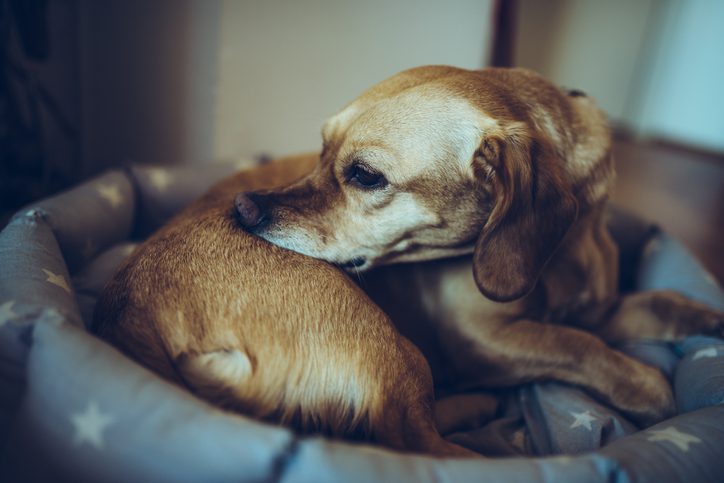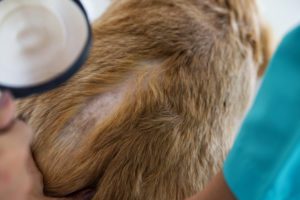Symptoms of Skin Inflammation
There are several causes of skin inflammation in dogs. Some of them are minor and can be treated with over-the-counter topical ointments. Others require diagnosis through blood testing and skin scraps. Treatments for serious skin problems can include topical ointments, oral medications, and intravenous medications.
The most common symptoms of skin problems in canines are easily recognizable. Chewing, licking, or biting the affected area is the first noticeable sign of a skin irritant, and one most pet owners will take notice of. You might also see wet spots or places where the fur is very thin or missing completely.
Closer examination of these areas might show scaly skin patches, a rash of red bumps, or pus like swollen nodules. Each of these conditions indicates some type of skin irritant that requires medical care.
Occasionally, a dog will get a “hot spot”, an area that is itchy and irritated. Frequently scratching or biting at this area can cause a secondary problem like open wounds or an infection. Over the counter sprays can be applied to hot spots to temporarily relieve the itchy feeling but testing by a vet is still necessary to determine the cause of the problem.

In some cases, skin problems can be caused by parasites like fleas and ticks or mange, a microscopic parasite that burrows into the skin and causes intense pain and itching. Medical treatments are available to rid your pet of these invaders.
Yeast infections, dandruff, and excessive shedding can also cause skin irritations for your dog. Many times, foot chewing will be a sign of a yeast infection or an allergy, perhaps to grass or pollen. Your pet’s veterinarian can give you medication to help relieve these symptoms.
What is Ringworm and How to Recognize it
One condition that can affect animals and humans is ringworm, which is not actually a parasite at all. Ringworm is a fungal infection that attacks the skin. It is caused by the mold spores in the Trichophyton, Microsporum, or Epidermophyton genera of the fungi family.
Dog with skin infections often have a scaly, itchy rash that appears circular or ring shaped. This is often accompanied by a raised red area on the skin and may have pus or discharge present. This is most commonly caused by a bacterial skin infection but could be ringworm instead.
Seeking Veterinary Care
Since so many skin conditions can have similar symptoms it is best to have your pet’s veterinarian make a diagnosis. A fungal culture from a sample of fur or skin is the only reliable way to diagnose ringworm. A skin scraping or treatment trial with a prescription medication may be recommended if mange is suspected. By far the most common cause of itchy skin and skin rash is a bacterial or yeast infection that is caused by allergies.

If your veterinarian confirms there is a ringworm infection they will likely recommend treatment with an oral antifungal medication as well a topical therapy. No matter what course of treatment is prescribed, be sure to use the recommended dosage for the prescribed number of days.
At-home Treatment
In addition, to any prescribed medications, treating ringworm on your dog will involve an extensive regimen of cleaning and disinfecting. Ringworm is highly contagious and can spread from pet to pet, pet to human, or human to human through minor skin contact.
In order to treat your pet at home, you will need to first isolate the animal. You can put the dog in a small room with a hard floor that is easy to mop and disinfect, or you can use a cage with a solid bottom. The dog will need to be away from other pets and children for 90 days or more. Ringworm can remain contagious for months, even on bedding, furniture, grooming supplies, and clothing.
Every article of clothing or bedding that the infected pet may have had contact with will need to be disposed of or washed in very hot water and a bleach solution or commercial disinfectant. This must be repeated every time the fabric comes in contact with the infected pet.
The ringworm fungus can also attach to furniture, toys, pillows, curtains, and rugs. For this reason, every inch of your house should be thoroughly cleaned and disinfected. Dust every day using a clean, disinfected cloth. Use a steam cleaner to treat carpets, rugs, and furniture. Then, vacuum surfaces every day and empty the vacuum bag. If your vacuum uses a dust cup, clean the cup with disinfectant solution.
Hard surfaces such as walls, floors, cabinet, or closet doors, and sliding glass should be cleaned and disinfected as well.
Children should be instructed to stay away from the infected pet and keep other pets away, as well. If the fungal infection does transfer to a household member you should contact your physician.
Summary
Ringworm in pets is not life threatening and is easy to treat. Like other skin problems, ringworm is more annoying than threatening. Treatment is easy but can be expensive and inconvenient because of the medications used and the intense nature of cleaning that needs to take place.
Recognizing ringworm is not difficult, but a trip to the veterinarian will be needed to confirm the fungus. Contact the office when you notice your dog displaying signs of skin irritation such as biting, chewing, or scratching one spot continually. The affliction might be ringworm, or it might be something else like allergies, yeast infection, or mange. Only your veterinarian will be able to make this determination and prescribe the proper treatment. Follow through with whatever medication and care plan the vet gives you. In the case of ringworm, this will involved isolation and care of your pet and his habitat.
